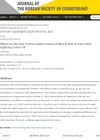Search
for
Sort by
Research
60-90 / 1000+ results
research Porosity at Different Structural Levels in Human and Yak Belly Hair and Its Effect on Hair Dyeing
Yak belly hair has higher porosity and is less stiff than human hair, making it absorb dye better but less suitable as a direct substitute for hair dyeing.

research Visually Scoring Hirsutism
The modified Ferriman-Gallwey method is a useful tool for diagnosing hirsutism.

research Studies of Light Scattering from Ethnic Hair Fibers
Different hair types from various ethnic groups affect hair shine due to characteristics like thickness and shape.

research Effects of Non-Ablative Fractional Erbium Glass Laser Treatment on Gene Regulation in Human Three-Dimensional Skin Models
Erbium glass laser treatment may help with skin remodeling, reduce inflammation, and improve skin cell maturation.

research Drug Delivery Applications of Three-Dimensional Printed Mesoporous Scaffolds
3D-printed mesoporous scaffolds show promise for personalized drug delivery with controlled release.

research Measurements for the Sales and Marketing Department
The document explains how to measure sales and marketing success and warns about misusing these measurements.

research Histologic Comparison of Microscopic Treatment Zones Induced by Fractional Lasers and Radiofrequency
Different lasers and radiofrequency affect skin differently, important for dermatologists to choose the right treatment.

research A Review on Herbal Shampoo and Its Evaluation
Herbal shampoo cleans hair well and is safer than regular shampoos.

research Quantifying the Effects of Repeated Dyeing: Morphological, Mechanical, and Chemical Changes in Human Hair Fibers
Repeated hair dyeing significantly damages hair.

research Quantification of Biotin in Plasma Samples by Column Switching Liquid Chromatography – Tandem Mass Spectrometry
The document describes a way to measure biotin in blood to prevent wrong test results in hormone level testing.

research Phototrichogram Analysis of Japanese Female Subjects with Chronic Diffuse Hair Loss
Phototrichogram and hair diameter measurements are effective, noninvasive ways to assess hair growth and detect early hair loss, with the most common pattern being reduced hair density.
research Ex Vivo SIM-AFM Measurements Reveal the Spatial Correlation of Stiffness and Molecular Distributions in 3D Living Tissue
Collagen makes skin stiff, and preservation methods greatly increase tissue stiffness.
research Loss of Epidermal Evi/Wls Results in a Phenotype Resembling Psoriasiform Dermatitis
Loss of a specific protein in skin cells causes symptoms similar to psoriasis.

research A Randomized, Investigator-Blinded, Controlled, Split-Scalp Study of the Efficacy and Safety of a 1550-nm Fractional Erbium-Glass Laser, Used in Combination with Topical 5% Minoxidil Versus 5% Minoxidil Alone, for the Treatment of Androgenetic Alopecia
Laser and minoxidil combo promotes better hair growth than minoxidil alone, safely.

research Pain, Itch, and Quality of Life in Persons with Keloids
Keloids significantly reduce quality of life, and treating symptoms should be prioritized.

research Effect of Castration and Finasteride on Urinary Oxalate Excretion in Male Rats
Castration and finasteride lower urinary oxalate in male rats, potentially treating urolithiasis.

research Reimagining Hair Science: A New Approach to Classify Curly Hair Phenotypes via New Quantitative Geometrical and Structural Mechanical Parameters
A new system for classifying curly hair types using precise measurements can improve hair care products and cultural inclusion.

research AKT2 Gene Polymorphisms, sRANKL/OPG and Hormone Measurements in Polycystic Ovarian Syndrome Women
Certain gene variations in AKT2 are more common in women with PCOS and are linked to higher levels of specific hormones and symptoms.

research A Discourse on Human Hair Fibers and Reflections on the Conservation of Drug Molecules
Hair analysis for drugs needs a better understanding of how drugs enter hair, considering factors like hair structure and pigmentation.

research Proceedings of the International Congress 'Science, Information, Spirit' 2007, pp 28-35: Electro Photonic Analysis of Hair and Non-Hair Fibers and Investigation of Different Hair Treatments
Hair properties change under electromagnetic fields and are influenced by individual characteristics and the environment.

research Activity and Safety of Cinchonine Nanostructured Lipid Carriers as a Hair Growth Stimulant in Mice Model of Androgenetic Alopecia
Cinchonine Nanostructured Lipid Carriers serum safely and effectively stimulates hair growth and increases the number and size of hair follicles.

research Age-Related Changes in Male Skin: Quantitative Evaluation of One Hundred and Fifty Male Subjects
Male skin gets drier and more alkaline as it ages, which may need different skincare than women's skin.

research Floral Attractants in the Black Orchid Brasiliorchis Schunkeana: Clues for Presumed Sapromyophily and Potential Antimicrobial Activity
The black orchid Brasiliorchis schunkeana produces chemicals that attract certain insects and have potential antimicrobial properties.

research Qualification of a New and Precise Automatic Tool for the Assessment of Hair Diameters in Phototrichograms
The new automatic tool accurately measures hair thickness and is reliable.

research Does a Picture of the Human Placenta Predict the Future?
The shape and size of the placenta may help predict future health risks for both mother and child.

research Effects on Hair Texture Improvement of Bleached Hair When Applying Castor Oil
Castor oil improves the texture of bleached hair by increasing its strength.

research Topical ALA-Photodynamic Therapy for Acne Can Induce Apoptosis of Sebocytes and Down-Regulate Their TLR-2 and TLR-4 Expression
ALA-photodynamic therapy helps reduce acne by causing acne cell death and lowering certain skin protein levels.

research Scalp Immersion Proxigraphy: An Improved Imaging Technique for Phototrichogram Analysis
SIP is a better method for measuring hair growth accurately.
research Pharmaceutical Evaluation of Different Shampoo Brands in Local Saudi Market
All evaluated shampoos meet Saudi standards.